Advertisements
Advertisements
Question
In a cyclic process, if ΔU = internal energy, W = work done, Q = Heat supplied then ______.
Options
ΔU = Q
Q = 0
W = 0
W = Q
Solution
In a cyclic process, if ΔU = internal energy, W = work done, Q = Heat supplied then W = Q.
Explanation:
In a cyclic process, the system returns to its initial state at the end of the cycle. Since the internal energy (ΔU) depends only on the state of the system, the change in internal energy over one complete cycle is:
ΔU = 0
From the first law of thermodynamics:
Substituting ΔU = 0
Q = W
Thus, in a cyclic process, the heat supplied to the system (Q) is equal to the work done by the system (W).
APPEARS IN
RELATED QUESTIONS
Explain why The climate of a harbour town is more temperate than that of a town in a desert at the same latitude.
A thermodynamic system is taken from an original state to an intermediate state by the linear process shown in Figure

Its volume is then reduced to the original value from E to F by an isobaric process. Calculate the total work done by the gas from D to E to F
An ideal gas is taken through an isothermal process. If it does 2000 J of work on its environment, how much heat is added to it?
What is a thermodynamic process?
Draw a p-V diagram showing positive work with varying pressure.
3 mole of a gas at temperature 400 K expands isothermally from an initial volume of 4 litres to a final volume of 8 litres. Find the work done by the gas. (R = 8.31 J mol-1 K-1)
An ideal gas of volume 2 L is adiabatically compressed to (1/10)th of its initial volume. Its initial pressure is 1.01 x 105 Pa, calculate the final pressure. (Given 𝛾 = 1.4)
Explain work done during a thermodynamic process.
Explain the thermodynamics of the isochoric process.
When food is cooked in a vessel by keeping the lid closed, after some time the steam pushes the lid outward. By considering the steam as a thermodynamic system, then in the cooking process
Give an expression for work done in an isothermal process.
Apply first law for an adiabatic process.
Give an equation state for an isochoric process.
Draw the PV diagram for the isobaric process.
Derive the work done in an adiabatic process.
What are the limitations of the first law of thermodynamics?
Among the amount of heat absorbed and the amount of work done by a system, ______
One mole of an ideal gas with `gamma` = 1.4 is adiabatically compressed so that its temperature rises from 27° C to 47° C. The change in the internal energy of the gas is (R = 8.3 J/mol.K) ____________.
In which of the following processes, beat is neither absorbed nor released by a system?
For an isothermal expansion of a perfect gas, the value of `(Delta "P")/"P"` is equal to ____________.
In an isothermal process, the volume of an ideal gas is halved. One can say that ____________.
Assertion: Equal volumes of monatomic and polyatomic gases are adiabatically compressed separately to equal compression ratio `("P"_2/"P"_1)`. Then monatomic gas will have greater final volume.
Reason: Among ideal gases, molecules of a monatomic gas have the smallest number of degrees of freedom.
An ideal gas is compressed to half its initial volume by means of several processes. Which of the process results in the maximum work done on the gas?
Consider P-V diagram for an ideal gas shown in figure.
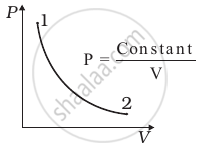
Out of the following diagrams (figure), which represents the T-P diagram?
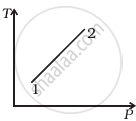 (i) |
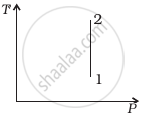 (ii) |
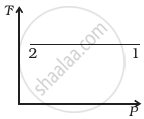 (iii) |
 (iv) |
In the figure shown here, the work done in the process ACBA is ______.
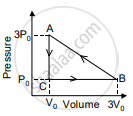
Explain the thermodynamic process.
When an inflated ballon is suddenly burst, why is the emerging air slightly cooled?
